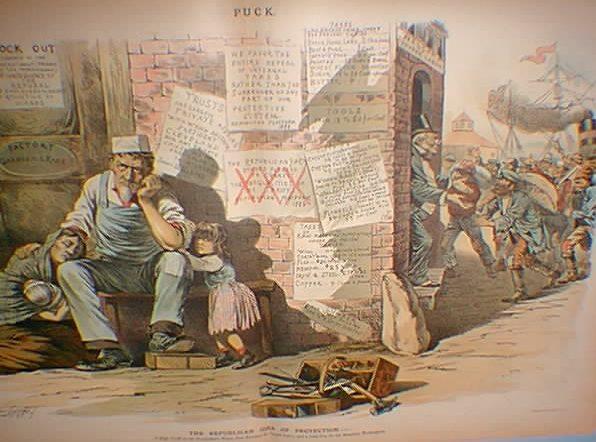Waves of Immigration

Immigration to the United States was influenced by both push and pull factors. The push factors were what drove the immigrants from their country such as religious persecution, political oppression and poverty. The pull factors were those which attracted immigrants to America such as civil rights, freedom of expression, religion and speech and economic opportunity.

Thus, the freedom, opportunity, and civil rights that were denied Europeans throughout centuries, and at the same time guaranteed to the immigrants, became the basis of the American value system and dream. The dream was that individuals would be given the opportunity through hard work to succeed. However, opportunity to succeed was all that was promised. The individual would be responsible for his own success or failure, and, in the latter case, often be left to himself to survive.
To better understand immigration, let us look at the four major waves. The colonial period was from 1607-1680 and established the basic division that eventually led to the Civil War. The first immigrants were called colonists because they founded the first colonies in America. There was a great difference between the types of colonies. In the northern colonies such as Plymouth, Massachusetts, Pennsylvania and Rhode Island, many colonists came for religious freedom. In addition, they had small farms and were what we would call middle-class. Many were well educated and through the decades developed industries, such as lumber, linen and woolen mills and shipbuilding, opened small shops, got involved in trading or became craftsmen. Their society was much more middle-class.
However, in the South, there were large plantations due to the mild climate and fertile soil. The original intention of the first southern colonies was profit. The first settlers in Virginia, for example, were fortune seekers looking for gold and trade routes. When those ideas failed, they turned to farming. They had enough capital to buy large sections of land, which formed the basis of a plantation economy based on large crops of cotton, tobacco and indigo. The plantations were like mini-societies where slaves or indentured servants did most of the work. There wasn’t much opportunity to develop a middle-class. The ideas of equality and opportunity were non-existent for the slaves and not as widespread in the South as in the North. The existence of slavery the “American tragedy” and along with the treatment of the Indians form the darkest chapters in American history. The question of slavery so divided the United States that it eventually led to conflicts, which would end in the Civil War.
The next period, called the first wave of immigration, was from 1680 to about 1776 where Scots-Irish and Germans were the major immigrant groups. After, the War of Independence, there was not much immigration until 1820.
The second wave of immigration from 1820 to 1890 was a period where America went from being mainly a rural and agricultural society to the beginnings of an industrial society. It was during this second wave, that many Irish and Norwegians emigrated. The Irish were highly dependent on the potato and when the potato crop failed in the 1840’s many either emigrated or faced starvation. Emigration was largely to Northern England or the United States.
Most of the Norwegians emigrated to the Midwest drawn by the promise of free land (the Homestead Act of 1862). By settling, building housing and farming the land, they were granted 160 acres (about 600 mål) of fertile soil, a farm that would make their former landlords’ farms seem like peanuts. They could write home to family and friends and brag about being large landowners.
During the latter part of this period, the United States grew to a major industrial nation and this growth continued on into the third wave, which was from 1890 to about 1930. During the third wave, the United States received a whole new type of immigrants. They mostly came from Eastern and Southern European cities and moved into American cities and worked in industry. The promised land began to seem less and less promising as immigrants were stuffed into tenement buildings in over-crowded cities and forced to work in factories under deplorable conditions. The immigrants soon discovered that American streets were not paved with gold. Nevertheless, immigrants poured into the United States where at least they felt that they had a chance. This wave continued until the Great Depression and World War II.
A fourth wave of immigration began in 1965 and is still ongoing. In this wave there is a mixture of Asians (Koreans, Vietnamese, Cambodians, Chinese and Japanese,) and Hispanics; people from Latin America and South America.
The Asians, as a group, are successful. The Asians’ success can be explained by two factors. Firstly, many of them, particularly the Chinese and Koreans, arrive with money and invest it wisely. They often start businesses and shops and work long hours. Secondly members of this group are often well educated, and value education for their children. Research shows that Asian children are more likely to go to a good school than other immigrant children.
Hispanics as a group have a high poverty rate. They are often poor when they arrive and have to make work a priority over education. In addition, a number of these immigrants come to the US illegally, which makes them vulnerable to exploitation. They often work for less money and can't complain about the working conditions for fear of being deported. They are also not eligible for help from government programs for as long as they are undocumented. However, over time we see that as families become established they begin to work their way into the middle class.
Today immigrants make up 14% of the US population. This number is expected to rise to 18% by 2065. It is also projected that Asians will become the largest immigrant group.
Comprehension
Vocabulary
Paste these text sections into your own text document and create a fluent text based on as many of them as possible.